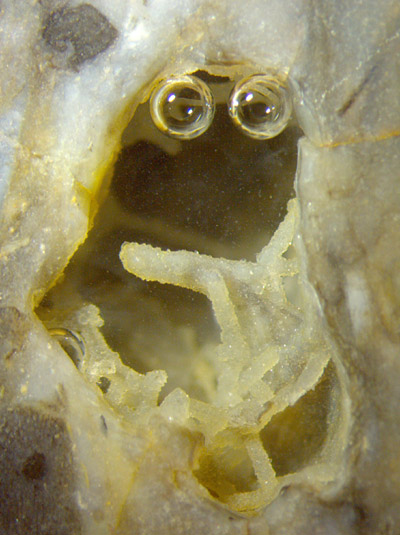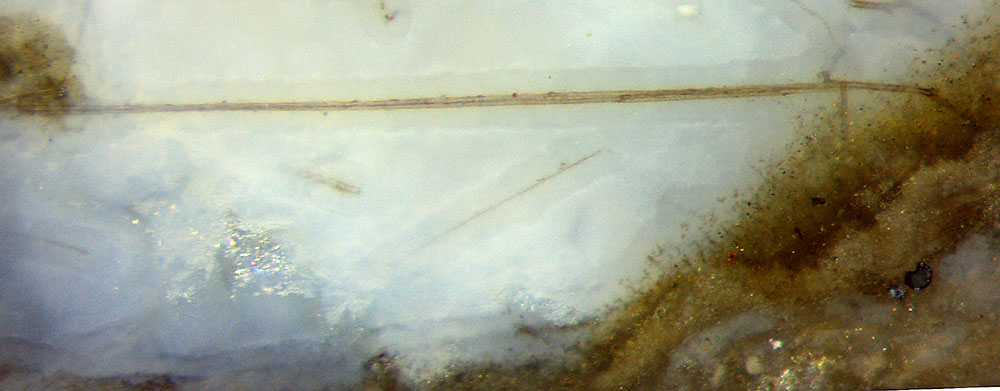Surprising aspects of
Devonian fungus hyphae
 Tiny air bubbles emerged slowly from the
murky depth of an
oil-filled cavity in Rhynie chert and arranged themselves such that the
reader may feel an intense questioning look from some alien with keen
eyes: Fig.1. They
detract the attention from the quartz-coated fungus hyphae in the
foreground but, serving as reduction lenses, reveal more coated
hyphae behind.
Tiny air bubbles emerged slowly from the
murky depth of an
oil-filled cavity in Rhynie chert and arranged themselves such that the
reader may feel an intense questioning look from some alien with keen
eyes: Fig.1. They
detract the attention from the quartz-coated fungus hyphae in the
foreground but, serving as reduction lenses, reveal more coated
hyphae behind.
Fig.1: Quartz-coated straight fungus hyphae crossing a cavity in Rhynie chert. Image width 5mm.
Straight
hyphae crossing small cavities are not rare. They are mostly not seen
but coated with quartz crystals, thus appearing as straight rods.
As an
extremely rare coincidence, a cut plane had unwittingly been chosen
such that it cuts through a cave with coated hyphae where it follows
right along the coating of a hypha,
thereby keeping at such a small distance from the hypha
that the latter is dimly seen through
the quartz all along: Fig.2.

Fig.2: Quartz-coated straight fungus hyphae crossing a
cavity in Rhynie chert.
Note the very thin horizontal hypha seen through the quartz.
Image width 4.5mm.
The hyphae growing in the water-filled caves were
virtually "weightless", hence weight did not interfere with growth.
However, this is not a satisfactory explanation of the observed
straightness. Coating with chalcedony and quartz made the hyphae heavy
but also stiff so that they could remain straight if stiffness was high enough. Otherwise the hypha could sag like a slack rope, as seen in Rhynie
Chert News 63 . As another possibility, silica gel could have stabilised the hypha being coated and dissolved later. (There are examples of cavities once filled with silica gel but empty now.)
It is well known that there are numerous fungus species in the Rhynie
chert [1]. A tendency to straight
hyphae is more or less distinct among them. No attempt is
made here to assign the straight hyphae to some species.
The hyphae of some fungi branch
and interconnect profusely without distinct straight parts in between.
Also without straight parts are the wavy or spiralling hyphae of the recently (2017)
discovered Devonian mycoparasite
resembling the recent Trichoderma.
The quartz coatings in Figs.1,2 indicate slow silicification with low
supersaturation of silica. With higher
supersaturation, the whole water-filled space may turn into
silica gel and later into chalcedony, as still seen in Fig.3.
 Fig.3:
Straight fungus hyphae in chalcedony, connecting rotten plant debris in
the former swamp water turned into Rhynie chert.
Fig.3:
Straight fungus hyphae in chalcedony, connecting rotten plant debris in
the former swamp water turned into Rhynie chert.
Image width 2.8mm, hypha thickness about 12Ám.
This
magnificient structure might remind the attentive reader of a "bridge
over troubled water".
Apparently
the "bridge" is made of two parallel hyphae touching mutually up to the
"pillar" on the right. Like with Fig.2, the reason for the perfectly
straight growth remains obscure. Fig.3 is even more enigmatic for the
slight but distinct change of direction at the "pillar".
The illusion of a seashore slope with lush
vegetation is brought about here by a thicket of microbes which
are not rare on former silica gel surfaces where they had apparently
formed a slimy layer before all turned into Rhynie chert.
Samples: Rh14/17.5 and Rh14/18.4, obtained
from Barron
in 2007:
Figs.1,2; Rh9/61.1
(0.13kg), found in 2004: Fig.3;
H.-J.
Weiss
2021
[1]
T.N. Taylor,
M. Krings, E.L. Taylor: Fossil
Fungi. Elsevier 2015.
 |
 |
173 |


 Tiny air bubbles emerged slowly from the
murky depth of an
oil-filled cavity in Rhynie chert and arranged themselves such that the
reader may feel an intense questioning look from some alien with keen
eyes: Fig.1. They
detract the attention from the quartz-coated fungus hyphae in the
foreground but, serving as reduction lenses, reveal more coated
hyphae behind.
Tiny air bubbles emerged slowly from the
murky depth of an
oil-filled cavity in Rhynie chert and arranged themselves such that the
reader may feel an intense questioning look from some alien with keen
eyes: Fig.1. They
detract the attention from the quartz-coated fungus hyphae in the
foreground but, serving as reduction lenses, reveal more coated
hyphae behind.
 Fig.3:
Straight fungus hyphae in chalcedony, connecting rotten plant debris in
the former swamp water turned into Rhynie chert.
Fig.3:
Straight fungus hyphae in chalcedony, connecting rotten plant debris in
the former swamp water turned into Rhynie chert. 
